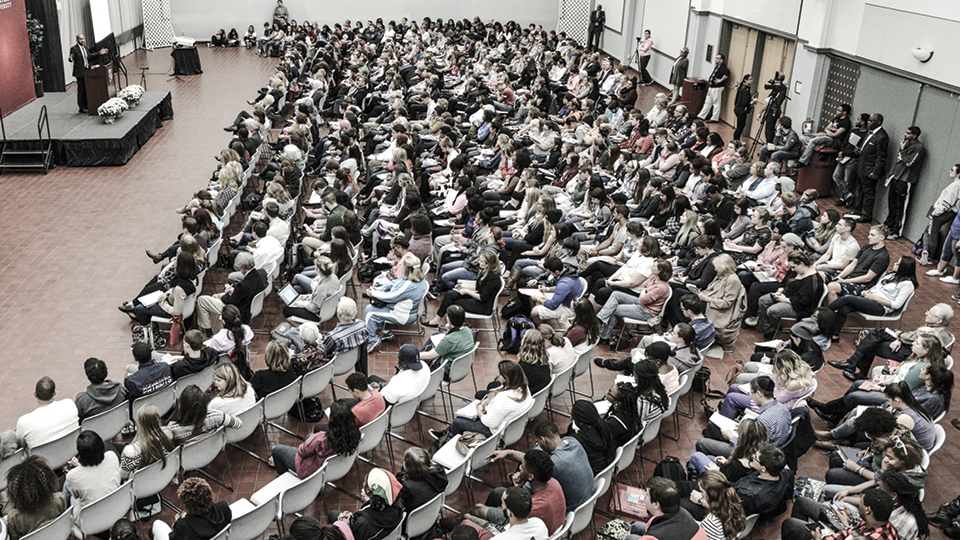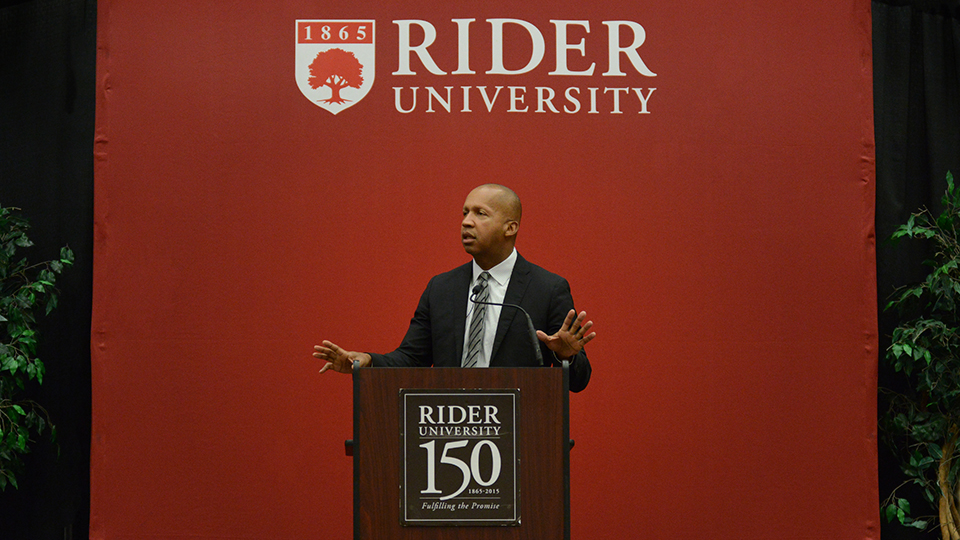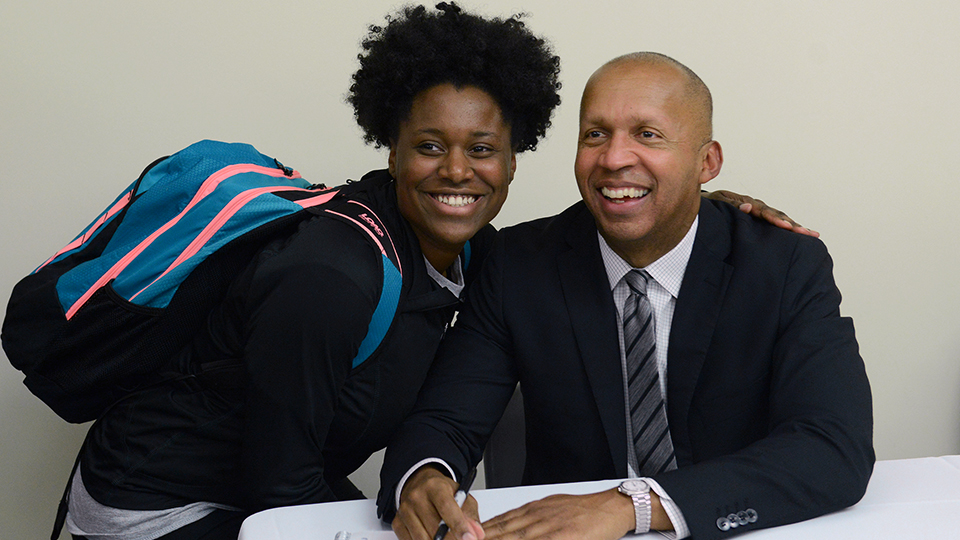by Aimee LaBrie
Walter McMillian suffered on death row for 15 years, convicted of a murder he didn’t commit. A boy named Charlie faced the death penalty after being tried as an adult for a crime he committed at 14. Ian Manuel spent 18 years in prison, many of them in solitary confinement, after being charged with attempted murder, though he didn’t pull the trigger. These are just a handful of the cases investigated by Bryan Stevenson’s nonprofit organization, the Equal Justice Initiative, and described in his New York Times best-selling book, Just Mercy.
This fall, Stevenson’s book and a personal visit to Rider’s Lawrenceville campus were part of Rider’s Shared Read Program, an initiative launched in 2014 by the Office of Academic Affairs to create campus-wide conversations about important social issues. Free copies of Just Mercy were distributed to all first-year students during summer orientation, with additional copies available for all members of the Rider community.
“We want students to see that being part of a university also means participating in topics relevant to our society,” says Professor Anne Law, special assistant to the provost, who leads this University-wide endeavor. “It’s not just about reading a book and writing a paper. It’s about using the text as a starting point for deeper discussions about difficult topics.”
Stevenson was born into a poor, racially segregated community in Delaware. An African-American, two of whose great-grandparents were slaves, he was the first in his family to attend college. At Harvard University, where he received both a master’s in public policy from the Kennedy School of Government and a J.D. from the School of Law, he was drawn to issues surrounding wrongful conviction.
Just Mercy focuses largely on his encounters with women and men who have been unjustly incarcerated or received extraordinarily harsh sentencing. Though many of his clients are African-American, Stevenson’s book and his lecture looked more broadly at what can go wrong in the justice system for those who don’t have the economic or social means to receive fair or skillful legal representation.
“We chose Just Mercy for the Shared Read Program on the heels of what was happening in Ferguson and Baltimore,” Law says. “Rather than steering students away from topics such as racial tension and social inequality, we want them to engage with one another, see different points of view and recognize that they have the power to create change in the world.”
The book, along with Stevenson’s lecture, galvanized students to become active participants in creating change as their understanding of social justice deepened. English major John Modica ’17 was one of 21 students invited to President Dell’Omo’s house in the fall to discuss Just Mercy. Topics touched on racism, the death penalty and the shooting death of Michael Brown in Ferguson, Mo.
The book changed the way Modica viewed his responsibility as a member of society. In a passionate op-ed published in The Rider News, the University’s student newspaper, Modica wrote: “We as a community must come to two understandings: that our conversations need to be oriented toward solutions, not complaints; and that when these important conversations are not present, our responsibility is to act until they form. I encourage everyone to listen to Stevenson’s words.”
Students react on social media to Stevenson's lecture
Communications major Leah Corcillo ’17 presented the book during freshman orientation this summer. Having worked on the first Shared Read in 2014, she recalls students having positive responses to last year’s book, The Glass Castle by Jeannette Walls, which only increased with this year’s selection. She attributes Stevenson’s power to his voice. “His writing came across as passionate but fair,” she says. “This is the first time that a book has made me more than care about an issue. Now I want to make a difference.”
Several students had the opportunity to dine with Stevenson in the Fireside Lounge prior to his lecture. Psychology major Hayley Francobandiero ’19 was truly moved by the experience. “It was amazing to meet such an inspirational person who was once just like me, unsure of what he wanted to focus on in college. I’m confident now that I want to stick with my goal of becoming a social worker or being a psychologist in the counseling field.”
On Oct. 14, 2015, Stevenson faced a packed crowd of more than 650 students, faculty, staff, alumni and community members in the Cavalla Room. Dressed in a gray suit, matching shirt and black striped tie, he spoke for almost an hour, without notes, about the criminal justice system, race in America and the need to create change. He talked about how in 1972 there were 300,000 people on death row and today there are 2.3 million; how 31 percent of black men have lost the right to vote in Alabama due to having a criminal record; how one in every three African-Americans born in this century is expected to be incarcerated.
Most importantly, he told the audience that it is up to each of them to get closer to problems, change the narrative, face uncomfortable truths and hold on to their hope. “All of my clients are broken,” he said. “They have suffered neglect, poverty, discrimination. I work in a broken system. It will break you. But it is the broken among us who will change the world.”
A week after Stevenson’s lecture, more than 30 students, staff and faculty gathered for a teach-in to share their thoughts and continue the conversation, not just about Stevenson’s visit and the book, but about the issues he addressed. Participants were black, Latino or white and ranged from first-year students to seniors.
Dr. Jonathan Millen, professor and associate dean of the College of Liberal Arts and Sciences, opened the conversation by asking students whether they had been doing what Stevenson suggested — having open discussions about issues that were uncomfortable.
Shemiah Dickens ’17 offered her recent experience. “I’m taking African-American history with Dr. Roderick McDonald, and, after Stevenson’s lecture, he asked the white kids in the class if they felt like they were privileged. Everybody was silent. That showed me that these are issues we’re still not sure how to discuss, even in a college classroom.”
An African-American student responded, “I agree, but on the other hand, I don’t want to have to educate all of my white friends about why it’s not OK to use the ‘N’ word. At some point, they have to take responsibility for their own understanding of privilege and discrimination.”
Another student announced her intention to become a judge. “I need to go to law school and find a way to make this right,” she said.
Three weeks later, on Nov. 18, 2015, the Black Student Union organized a demonstration in support of the black students of the University of Missouri, where a series of racially charged incidents (including racial slurs directed at students of color and a swastika that appeared on a university residence hall) were perceived as being unaddressed by the administration. Posters about the Rider event called for students of all backgrounds to join together outside of North Hall, wearing black attire to peacefully assemble in a show of solidarity “because discrimination is still an issue, and it goes beyond black and white.” The demonstration, which lasted eight hours, brought dozens of students together from all races and backgrounds, many of whom signed a shared board with their name and messages like, “I will stand for change in the face of adversity,” “#BlackLivesMatter” and “racism has no place here or anywhere.”
Corcillo believes that this public display of support would not have happened without the energy created by the Shared Read. “Many students realized that they needed to be active and to speak out,” she says. “This was more than just a group assignment — it was a catalyst for change.”
To keep these conversations active, the University is planning regular discussion groups around issues of race and inequality. “Complex issues are not solved solely by talking about them, but they are certainly also not dealt with by silence,” Law says. “Our goal is to create ongoing discourse open to all students, in part so that we can address Stevenson’s call to ‘get proximate’ to the issues that matter today.”
Prior to Stevenson’s lecture, six students were active tutors in Rider’s chapter of Petey Greene, an organization that assists the local youth prison population. Under supervision, students meet with inmates, helping them to study for their GED and to get ready for life after their sentences are served. After Stevenson’s lecture, Asia Marche, Rider’s Petey Greene chapter president, said that the numbers of those reaching out to her to participate had doubled. “We expect to have as many as 25 students trained and active this semester,” she says.
For her own part, Marche found that the book and Stevenson’s lecture deepened her dedication to service learning. “I already knew that what I was doing would make a difference in the lives of the people we tutor, but it also became clearer to me that as a society, we must take care of all of our members,” she says, recalling Stevenson’s core belief that each of us is more than the worst thing we’ve ever done.
“That idea stayed with me,” Marche says. “Whatever someone has done, he or she should not be defined by that one moment. Every person deserves to be treated like a human and given the chance to make a better life. We can help do that.”
Stevenson concluded his talk with a clear call to action. “We are the kind of people who want to make a difference in the world, to create more justice. We can do that. Each of us can do something that changes the justice, peace and hope quotient in this country.”
Modica, who wrote the op-ed, is one such ambassador of hope. He has made good on his own plea for more action. As one of the newest members of the Petey Greene program, he starts tutoring inmates this spring. “Stevenson’s message of love — both in print and in person — proved to be exactly the advice I needed,” he says. “That’s why I reached out to Asia Marche and set myself on the path to start tutoring people in prison this semester. Stevenson taught me that we all deserve a chance, and none of us should be denied that if we have the willingness to learn.”



